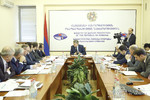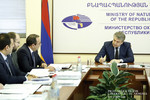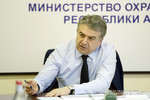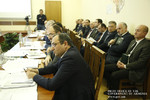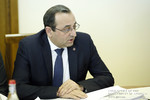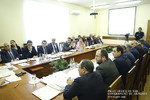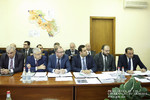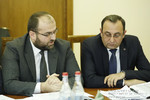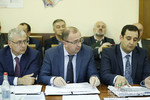Tuesday, 6 February 2018
PM Introduced to Nature Protection Ministry’s 2017 Activities
Prime Minister Karen Karapetyan visited the Ministry of Nature Protection to get acquainted with the activities and priorities completed in 2017, as well as the tasks set for 2018.
Minister Artsvik Minasyan reported that 21 activities as specified in the 2017 Government Program had been implemented within the prescribed timeframes. 17 of them have already been given a relevant government decision, 4 projects are under discussion. Seven out of nine priority actions have been completed within the defined timeframes, and draft government resolutions have been prepared for the remaining two projects.
In the period under review 52 legal acts, developed by the Ministry, were adopted in accordance with the established procedure. The volume of electronically processed documents increased from 41.6% to 60% in 2017 as compared to the same period last year. The water use permit issuance deadline was reduced from 180 to 50 days.
Artsvik Minasyan presented the findings of the surface water facility and atmospheric air quality monitoring they carried out in 2017. The quality of water in Lake Sevan has not undergone significant changes, and a serious achievement has been achieved - transparency has reached the mark of 13meters: such an indicator was typical in the Soviet era - before the enforcement of the water discharge arrangement. In some areas risky indicators have been registered.
Prime Minister Karapetyan underscored that if the findings of the monitoring seem to be alarming, the Ministry should take appropriate actions to change the situation.
“We need to clearly define the sequence of steps to ensure that the monitoring is not an end in itself. Any monitoring is initiated with a view to changing something,” the Head of Government emphasized and instructed the Minister of Nature Protection to provide information on the activities carried out in the period from 2014 to 2017.
First Deputy Minister of Nature Protection Erik Grigoryan reported on international cooperation in the field of environmental protection, grants and EU-Armenia cooperation in 2017. Over USD20 million-worth grant contracts have been signed with the Green Climate Fund, 22 environmental conventions and protocols are being implemented, of which 8 are regularly reported under the GSP+ Tracking Survey.
Talks are underway with the German KfW Bank on a grant of € 21.7 million for Biodiversity and Forestry Support Program, and a USD 28 million grant with FAO. 32 communities have been supported under the Support for Protected Areas - Armenia project; a program is being implemented to funnel grant funds to the budget; efforts are underway to approximate dozens of environmental and climatic settings for Armenia within 8 years following the entry into force of the EU-Armenia Association Agreement.
Highlighting the efficiency and targeting of grant spending, Karen Karapetyan emphasized that each project, including grants, should lead to applied results. He instructed to take stock of all existing and potential partners providing grants and work on developing targeted cooperation.
Deputy Minister Khachik Hakobyan presented the current trends in ecotourism and the activities scheduled for 2018. It was reported that in 2017, 549,128 tourists visited the protected natural areas (492,244 in 2016), as a result of which 226.77 million drams were received (179.40 million in 2016). An ecotourism information stand has been set up in the Nature Museum of Armenia which is supposed to host tourists in 2018.
The Head of Government noted that in terms of tourism development, one should aim more ambitious and achieve more serious indicators, given the existing potential. In this context, Prime Minister Karapetyan instructed the Ministry to continue working on Sevan National Park’s development and reform strategy, as well as to submit the Khosrov Forest State Reserve Development Program.
Khachik Hakobyan next provided information on the situation and developments in the Ararat valley water resources: in 2017, one deep well was liquidated, 16 were conserved, and 150 wells were brought into the valve regime, resulting in savings of up to 4952 liters per second, which makes 156 million cubic meters per annum. 23% efficiency was recorded in the fishery sector alone.
The Prime Minister was also informed about the process of forest sector reforms and the structural changes in ArmForest SNCO. Karen Karapetyan noted that the SNCOs operational under the Ministry’s jurisdiction should have a business component and provide profitability in addition to their statutory functions.
“Each SNCO director should have set a pre-determined horizon. If they have the opportunity and potential to occupy a market niche, we will surely tell them which way to go,” the Head of Government said.
Coming to the planned reform in ArmForest SNCO, the Premier stated in part, “We are firmly determined to make of ArmForest a profitable and powerful public structure without the risk of any breach of environmental norms.”







